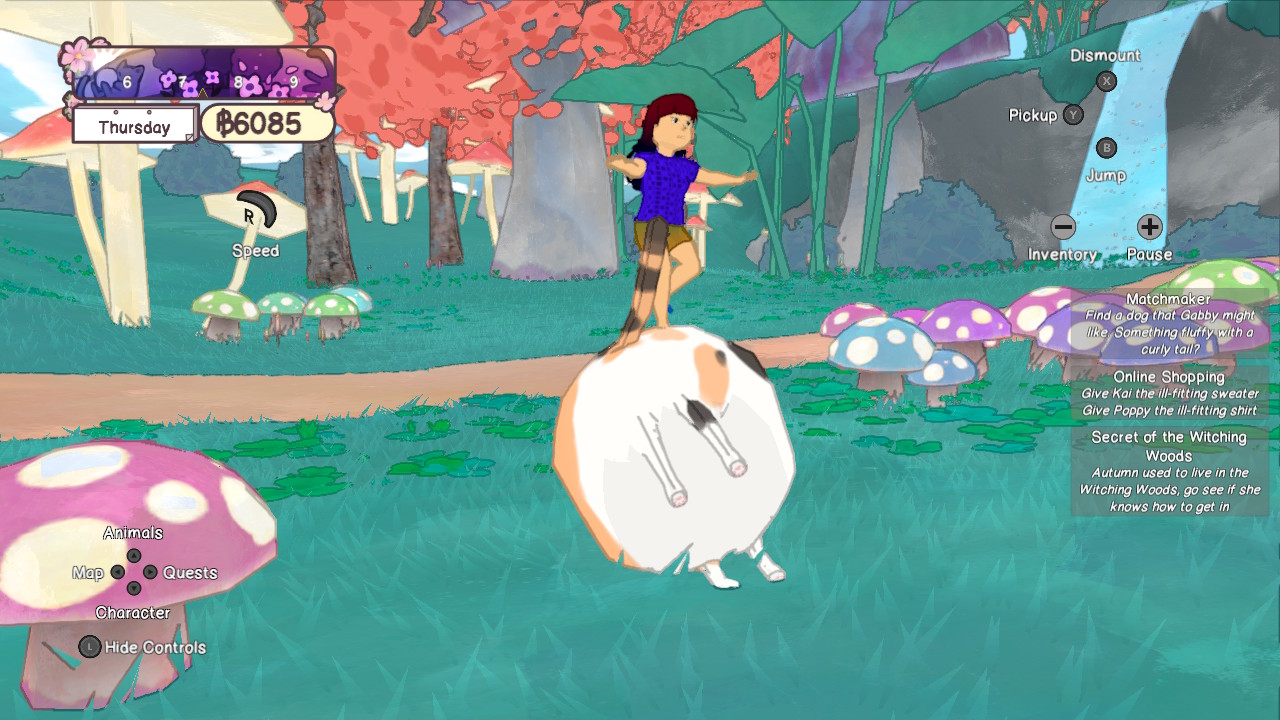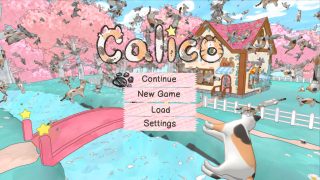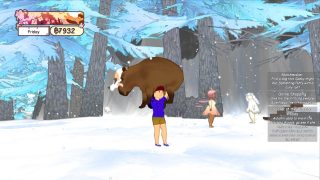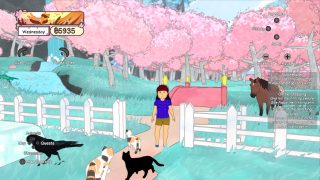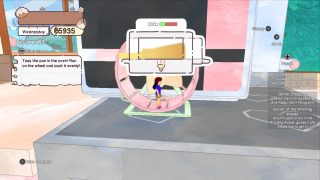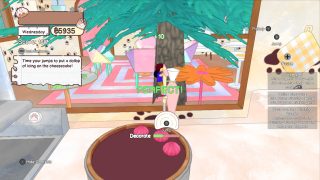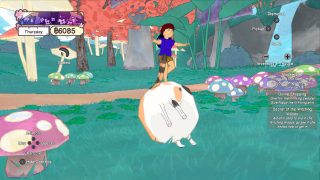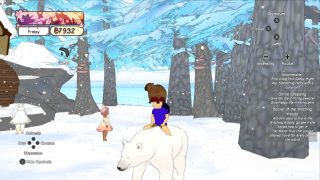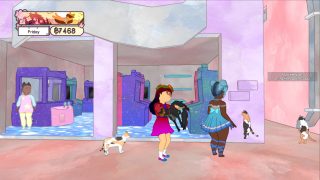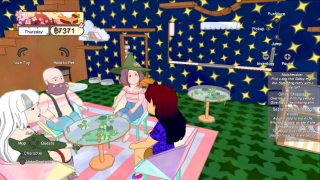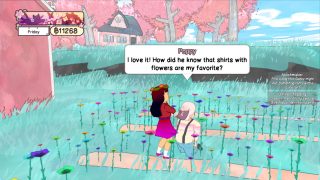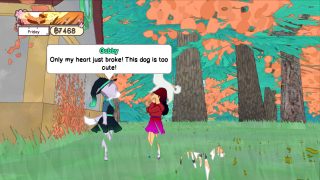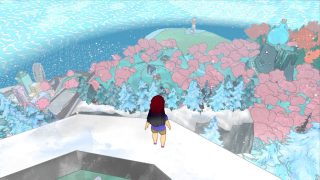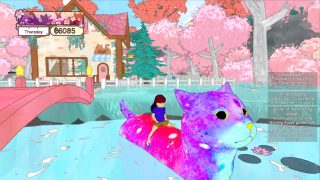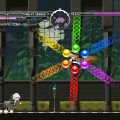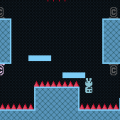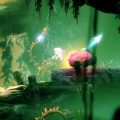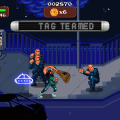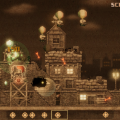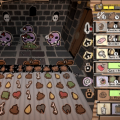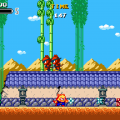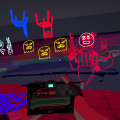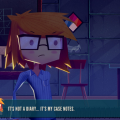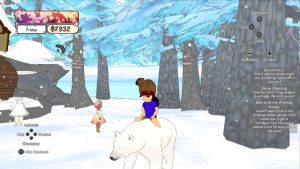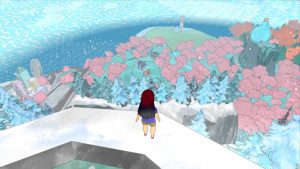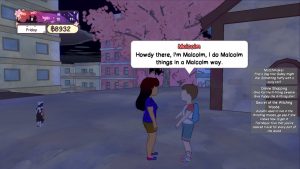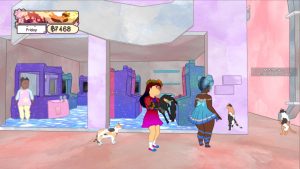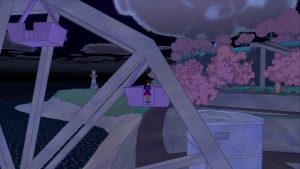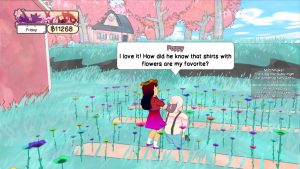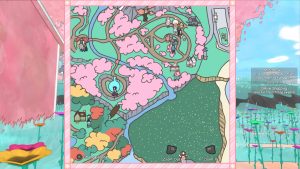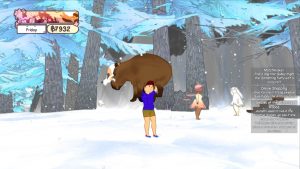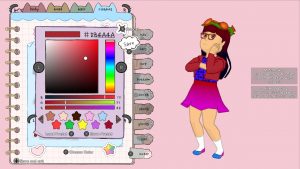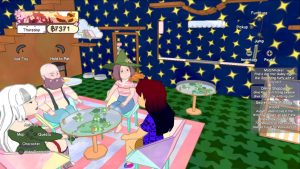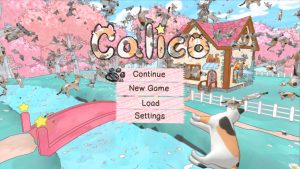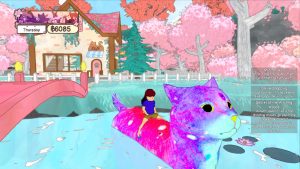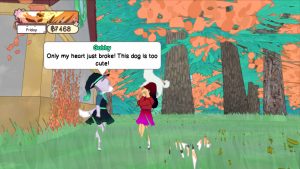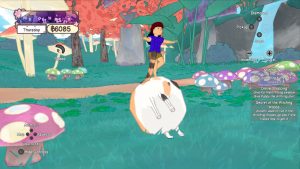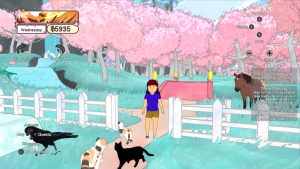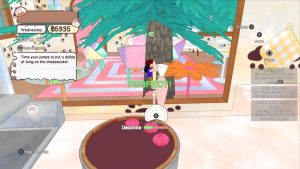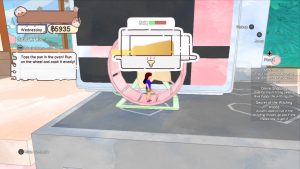Video games are about many kinds of experiences. Some are about challenge. Some are about competition. Some are about experiencing a story in an interactive form. Some are about experiencing a fictional world, and immersing yourself in it. And some are straight up about play, goofing around, and interactivity.
Calico falls into that last category. While there is a goal, it comes in a distant second place compared to the real focus of the game: goofing around in a world that combines the cutesy and adorable with the totally bonkers.
Calico is a game where you put a cat on your head, then cast a spell to enlarge a capybara so you can ride it, while having an enchanted shrunken polar bear float behind you like a balloon while you’re carrying a deer. Ostensibly, it’s about running a cat cafe, which is a cafe where cats and other adorable animals hang out while people come in to buy food and chat.
The story begins with you creating your character, then being introduced to the mayor of the town. You already have a cafe, and some basic furniture. Your job is to grow that cafe and get more food to sell, more decorations to put in there, and make more money from the townspeople coming in and buying your food, as well as do favors for the people in the world.
The game’s cafe business simulation is pretty simple. You can buy additional furniture styles and decorations from stores, and doing so sometimes makes certain people more likely to visit your store. Some people have favorite foods, and you have to make those foods once before they can be sold an infinite number of times. Talking to characters in the world will often reveal missions, whose objectives are typically things such as “talk to this person at this time/place”, “make this food” or “find this particular animal.” Completing the major objectives will unlock new locations to visit, opening up the game’s six-area world.
If you play through the game and simply follow all your objectives and rush through to the end as fast as possible, you’re missing the point. Like games such as The Legend of Zelda: Breath of the Wild, Deadly Premonition or A Short Hike, the goal isn’t the point. Instead, the point of the game is everything else you do along the way, or even ignoring the goal entirely simply to experience the world and immerse yourself in it and have fun.
Because there is a lot you can do, and a lot of it is just silly and ridiculous.
First, there’s the way you make food. Before the January 2023 update, it was silly but simple: you shrunk down to the size of a mouse, picked up ingredients and tossed them into a bowl to transform into the chosen food, which could then be sold infinitely to customers. But the update changed that, replacing it with a vastly more involved system.
After the update, the process of cooking and selling food became detailed that it’s practically a game in itself, divided into a multitude of minigames. First, using a series of spoons as launchers, and a tiny elevator to reach a high up shelf, you find the ingredients, which must be thrown or poured into a cauldron. After that, the real fun begins.
Depending on the food being prepared, you play minigames ranging from running on a hamster wheel to move cooked food left and right in an oven to cook it evenly, use a pogo stick to place frosting on a cake, ride a slab of butter to fill a pan, decorate coffee with milk and chocolate, and more. Most minigames are very forgiving, though some can be difficult, like the one where you have to knock fruits into the pockets of a pool table by literally playing pool.
Once the food production is finished, you receive a star rating based on both the time taken and score achieved from the minigames. The star rating results in customers giving you extra money when they buy your food, until you run out of fresh copies of the food and are left with unlimited “stale” copies that pay less, until you decide to cook more fresh food again in the minigames to raise the prices again. This encourages players to re-cook previously cooked foods to keep their money supply high, but it doesn’t require them to.
Then there’s the major focus of the game: the animals. There are cats galore, but there are also animals such as birds, polar bears, capybaras, rabbits, deer and other creatures as well. You can pick them up and pet them, or ride them if they’re large enough. You can even put small animals on your head and wear them like a hat, or put them on the head of a large animal to have one animal wear another. Later, things get even sillier, when you encounter backflipping cats that can follow you, and a large ball-shaped cat you can stand on and ride.
Once you pick up an animal (even ones large enough to ride can still be picked up), you gain the ability to command the animal to follow you, live in the cafe, or be free and head off into the wild. You can not only give these commands on the spot, but also from a menu that lists every single animal you’ve ever picked up. Which means you can command an animal in the cafe to show up by your side in the wild – and it’ll be there within seconds. There are also toys you can use to play with the animals, such as a ball on a string, a ball you can throw for animals to fetch (even animals that don’t fetch balls in real life) or a remote control mouse.
There’s also many potions you can buy. They have effects that are more about just having fun than anything else. You can turn your hair into a starry void, change the weather, enlarge or shrink animals, make them float like balloons, and do other completely ridiculous things.
The main reason to do the game’s objectives is to earn more of these things to goof around with. Earning more recipes to cook more foods, earning the ability to go to other areas, and getting new furniture sets unlocks more things to do and interact with. The game may appear to be open world, but areas are blocked by both invisible walls and visible obstructions such as road cones or a giant cat stuck in a log, until you’ve unlocked that area. As areas open up, the world becomes more open. Completing the game even earns you the ability to fly everywhere on a broom!
The town life simulation is very simple but works well enough to give the game a feeling of life. The townspeople walk to places often at random, or at certain points in that character’s story, such as going to a club or going to talk to a particular character. You can view a map and see where every character in town currently is, which is useful for tracking down someone you’re looking for if you need to buy something from them or complete a quest. Question marks are used on the map to represent characters you haven’t met yet. Characters also randomly walk to your cafe and buy things, staying to sit and hang out for a while. In fact, they buy things even if you’re not there – you’ll see a pop-up indicator of who bought what appear onscreen.
People visit your cafe more often if you’re selling food they like or have decorations they like. This is basically how you earn money, which is of course used for more decorations and types of food to cook, as well as outfits to wear. These things can also be earned by doing favors for the townspeople.
And there is a massive variety of these outfits and decorations, which can be placed both outdoors and indoors. Tables, chairs, beds, trees – yes, trees can be placed indoors if you want. The laws of physics and common sense already stopped applying in a game where you can pick up a polar bear while riding a cat, so an indoor tree that’s so big it clips through the cafe is hardly stretching plausibility at this point. You can even move your bed outside and sleep there, which probably sounds totally normal by comparison.
Sadly, talking to people visiting your cafe does not reveal any new dialog, as the character only says the same things they’d normally say. In fact, that lack of varied dialog is part of the game’s overall lack of polish. This isn’t Animal Crossing or Deadly Premonition, where characters change their dialog based on time of day, weather or location they’re encountered in, but instead pretty much only change it based on your progress in the story. Once you’ve fully completed the story and done everything that needs to be done, all they have left to say is that they don’t need any help.
The lack of polish carries over to just about everything else. The presentation, while quirky, is also seemingly unfinished, although the updates polished some of it up a bit. The soundtrack is limited to a theme song, a day and night song for each of the game’s six areas, and a cooking minigame song – 14 songs in total, two with lyrics. The cel-shaded graphics originally had very thin outlines that would frequently break, though the 2023 update thickened the outlines a lot and fixed them up, resulting in new screenshots for this article. There’s barely any transitions in the game – for example, when you shrink to make food, you’re just suddenly small and on the counter, until you finish the job, then you’re suddenly normal sized and on the floor again, without so much as a puff of smoke or any other effects.
The big city area feels rather empty for what’s supposedly a bustling and busy city, though it does actually have dozens of citizens in the form of cats that walk on their hind legs, and only a small number of humans. When you’re inside a building, ceilings and walls vanish to make it easy to see where you are, which is very useful, though it looks a little weird in practice. Characters talk about things they’re planning to do – go on a date, do a photoshoot – but are never seen doing them. Instead, they simply walk from place to place. A few characters are at least seen doing animations for things they’re interested in, such as planting flowers or dancing.
The menu system is not intuitive. It lets you look at your inventory, check a map, look at a list of all the characters and how much they currently like you, look at which animals you’ve interacted with so far and their current status (staying at cafe, following you, or free in the wild) and even change that status (e.g. commanding an animal who’s staying in the cafe to seek you out and follow you instead), and check your quest list, but navigating these menus can be tricky to figure out. Quest reminders must be manually turned on, so you don’t forget what you need to do in order to progress. The fact that you press a button to bring up the color change menu for hair/clothes/furniture isn’t immediately apparent either. Some parents might need to help their kids with the menus.
There are also strange (but not game-breaking) glitches that can occur, like animals going wild around the cafe and jumping and running all over the place, NPCs occasionally getting stuck (a patch was released to teleport stuck NPCs that are important to quests just in case), standing through chairs or even doing things like sliding through the front wall of the cat cafe to sit on the couch (if the couch is positioned close to the wall, that is; plus, you can do it too!). Multiple patches improved upon the jank that previous versions had, such as vastly improving the character creation screen, and improving major issues with the framerate which would occur at the cafe, but there’s still a fair amount of jank.
On a more positive note, there is only one initial loading time when the game is started up, and that’s it – traveling through the world is seamless. Patches added some nice new features such as the ability to disable the HUD at any time, as well as choose the colors of furniture, use color gradients in your outfits, and change the floor and wall design of the cafe. The character creation system was also totally overhauled in a patch and made easier to navigate.
Despite the lack of polish and feeling unfinished even with the updates, the game just oozes a distinct charm. The townspeople are incredibly diverse, and even include some part-human/part-something-else creatures. The world feels fairly alive, with moving clouds, changing weather, a day/night system, and people moving around and visiting each other and stopping by your cafe. The mood seems to be one of a largely conflict-free, very chill world, where everyone just accepts each other and has only minor problems in their lives. The worst of their problems seem to be “I accidentally turned one rabbit into seven rabbits while trying to make a rabbit rainbow colored” and “a giant cat is stuck in a log, so I can’t go to the forest.”
The locations are also pretty diverse – there’s a city, a snowy mountain, a forest with pink trees, another forest with green and orange trees, a wide open field with a lighthouse, and a land of giant mushrooms. You can ride a Ferris wheel in an amusement park. There are rivers, waterfalls, a hut on top of a mountain, all kinds of variety. You can sometimes get up pretty high and get a great view of the world from atop a mountain. There are also lots of hidden secrets to find, such as a giant transparent cat with a starfield for a body, or a hidden cave behind a waterfall with a vending machine. Some of the game’s more important areas, like the cat cafe and potion shop, are easily recognizable from a distance – the potion shop is on top of a mountain and shaped like a giant potion, and the cat cafe spews smoke from its chimney that rises well above the trees. This helps players find these areas if they might be lost.
The art direction of Calico is very distinct. Every area has a strong visual identity, from the whites and light blues of the snowy mountain, to the green and orange leaves of one of the forest areas, or the pink leaves of the main town, or the tall buildings of the city. Pastel hues abound, resulting in a larger contrast with colors that are designed to stick out, such neons. What Calico lacks in budget and polish, it makes up for in imagination and interactivity.
Imagination is probably the best way to describe it. Calico seems laser-focused on being cute and imaginative to the point of being completely insane. Why can you carry a horse? Why can you summon rain? Why can you make your hair glow in the dark? Why can you turn a cat giant, then make it float in the air? Why can you command an animal that’s a mile away to show up by your side? Why do you have to shrink in order to cook food? Why?!
Because it’s cute. Because it’s imaginative. Because it’s fun. Calico isn’t concerned with making sense. While it may be a game with a theme like no other, Calico is in some ways the most video-gamey video game out there. It’s not trying to be realistic or based on anything comparable to the real world. It’s about “magical girls running cat cafes,” as the tagline goes. It delivers a world that could only exist in a video game, breathes life into it, and then lets you go completely wild. It provides you with an original experience that only a video game can.
